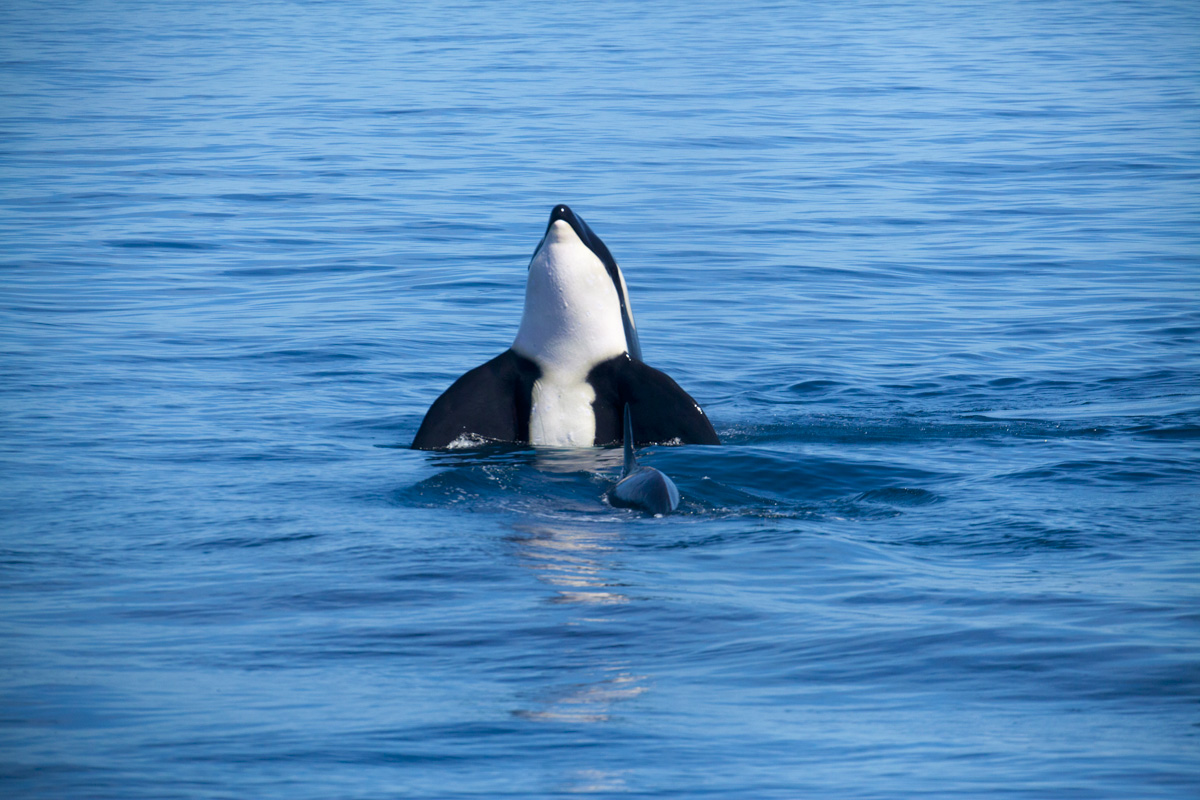
From the Realms of the Dead: Killer Whales in Raja Ampat
Latin Orcinus (“of the realms of the dead”), from Orcus + -inus
After breakfast we resume our hunt for whales and dolphins heading south west into the heart of the Dampier Strait.
A slice of nutrient-poor Pacific Ocean water pushes into the narrows from the east to meet bountiful currents and upwellings from the other side. In this three-dimensional world, fish and squid concentrate in the layers between vast water masses. At their boundaries, currents extend, like tendrils. Surfacing they appear like silky patterns, a tell-tale sign of activity below.
Pygmy Sperm Whales live here, enigmatic and poorly-known cousins of the gigantic and familiar Moby Dick. They are stealth-hunters that spirit themselves between aqueous layers, ambushing unsuspecting prey. They make little sound and are undetectable at the surface, except on the calmest of days. They lie motionless, breathless at the surface, the only give-away, the familiar falcate dorsal fin we associate with most cetaceans. Normally, long before we have chance to get anywhere near, they slip away as obscurely as they appear.
We are approaching an area we’ve seen them before when at the horizon a tall black dorsal fin pivots on top of a muscular black body. We approach closer and there are cries of ‘Killer Whale!’ It’s been three years since they’ve have been seen on this trip and here there are two together. The excitement is palpable as we angle the boat on an intercept course.
Surface footage and production by Simon Mustoe, Wildiaries. Photo by Christelle Lenain. Drone footage provided by Rudi Spaan https://www.spaansway.com/
The killers are tracking the upwelling zones, using them like a road map, to find their prey. There’s a burst of activity just off the starboard bow. Their languid but powerful surfacing and coordinated behaviour indicates an intention but as yet, we do not know what.
All of a sudden there is something among them. The Killers have trapped a Pygmy Sperm Whale. For how long has this pursuit been in play? They aren’t swimming fast. Maybe they have been tiring it for hours, coaxing it to the surface. There is nowhere left to hide.
The poor whale makes a futile attempt to escape by leaping clear of the water, the last indication of the terrible fate that awaits. It’s little more than three metres long, a third of the length of the adult male Killer Whale. With a final pounce and crushing blow between jaws, it’s all over. A cloud of blood fills the water and there are gasps from the guests and mixed feelings about what we are witnessing.
We launch a drone to document this rare occurrence, a view less oblique than our limited surface perspective. On the footage we can see both whales in turn carry the sinking carcass skywards, tail-first. They lunge through it, scattering pink foam as they tear it apart and consume the spoils evenly.
We can hardly believe the brutality but it may explain why we found no dolphins at all in our journey to the Strait yesterday. For the Pygmy Sperm Whale, resident here and occurring as only a small handful, dependent on a tiny habitat area, there was no hope of escape, no chance of safety in numbers.
For the Killer Whales, they need about 170kg food a day to survive and are perpetually on the hunt - some, like these perhaps, specialise on predating other whales and dolphins. An adult Pygmy Sperm Whale might qualify as just enough food for one day, between the two animals we saw. Both species coexist in an arms-race between predator and prey and we have to be careful not to interfere.
So we continue to follow them for a while at a distance. They are swimming slowly, no doubt exhausted from their recent efforts but aren’t interested in socialising with us. Maybe they are hungry or tired. Either way, they become increasingly elusive and we soon leave them alone.
If there was ever doubt about the true nature of Killer Whales, for the guests on this trip, the experience will have been affirming. It’s a reminder of the wild nature of Raja Ampat and that alongside beauty there is always tragedy, that everything has its place and that death. However confronting, this is part of a cycle that supports the richness of life in the most important marine area on Earth.
BOOK A SPOT ON OUR NEXT TRIP IN FEBRUARY 2020: https://indonesiatravel.com.au/travel/raja-ampat-whales-dolphins-snorkelling-and-diving-expedition
